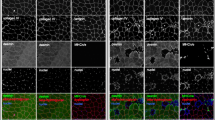Summary
The formation of a connective tissue scar was studied autoradiographically 2–42 days following standard contusion injury in the gastrocnemius muscle of 30 rats. The rats were injected intraperitoneally with 3H-labeled proline 4 h before the muscle samples were taken. On day 2 the majority of cells in the injured area were identified as inflammatory without radioactive labeling. Abundant labeling was observed, however, over the extracellular substance, and moderate labeling with 3H-proline in the cells identified as fibroblasts or their precursors. During the first 2 weeks the number of fibroblasts increased and the majority of them were labeled with silver grains, which were also present over the connective tissue matrix. Six weeks after injury only a few fibroblasts showed labeling, and no labeling was observed extracellularly in the connective tissue. Thus, it seems that the synthesis of extracellular connective tissue components in injured skeletal muscle occurs as early as 2 days after trauma, is intensive between days 5 and 21 after trauma, and decreases markedly during the following 3 weeks.
Zusammenfassung
Die Reaktion des Bindegewebes während Ausbildung einer Narbe wurde autoradiographisch vom 2. bis zum 42. Tag nach Standardkontusion im m.gastrocnemius von 30 Ratten untersucht. 4 Stunden vor Entnahme der Muskelproben wurde den Ratten 3H-markiertes Prolin intraperitoneal appliziert. Am Tag 2 wurde die Mehrzahl der Zellen im verletzten Gebiet als inflammatorische Zellen ohne Radioaktivität identifiziert. Eine reichliche Markierung fand sich jedoch über der Extrazellularsubstanz, und eine gleichförmig schwache Markierung mit 3H-Prolin in den Zellen, die als Fibroblasten oder deren Vorstufen angesprochen wurden. Während der ersten 2 Wochen nahm die Zahl der Fibroblasten zu, die Mehrzahl war mit Silbergranula markiert. Silbergranula fanden sich auch über der Bindegewebsmatritze. 6 Wochen nach der Verletzung waren nur noch wenige Fibroblasten markiert, während das Bindegewebe extracellulär überhaupt nicht mehr markiert war. Offensichtlich beginnt also die Synthese von extrazellulärem bindegewebigem Material im verletzten Skelettmuskel schon 2 Tage nach dem Trauma, ist intensiv zwischen dem 5. und dem 21. Tag nach der Verletzung, und nimmt deutlich ab innerhalb der nächsten 3 Wochen.
Similar content being viewed by others
References
Bailey AJ, Robins SP (1976) Current topics in the biosynthesis, structure and function of collagen. Sci Prog Oxf 63:419–444
Bailey AJ, Shellswell GB, Duance VC (1979) Identification and change of collagen types in differenting myoblasts and developing chick muscle. Nature 278:67–69
Bazin S, Delaunay A (1964) Biochimie de inflammation. VI. Fluctuations du taux de collagène et des protéines non fibrillaires dans types differents de foyers inflammatoires. Etudes comparatives. Ann Inst Pasteur 107:163–172
Bennett HS, Wyrick AD, Lee SW, McNeil JH (1976) Science and art in preparing tissues embedded in plastic for light microscopy with special reference to glycol methacrylate, glass knives and simple stains. Stain Technol 51:71–97
Gabbiani G, Le Lous M, Bailey AJ, Bazin S, Delaunay A (1976) Collagen and myofibroblasts of granulation tissue. A chemical, ultrastructural and immunologic study. Virchows Arch B [Cell Pathol] 21:133–145
Gay S, Viljanto J, Raekallio J, Penttinen R (1978) Collagen types in early phases of wound healing in children. Acta Chir Scand 144:205–211
Jozsa L, Reffy A, Demel Z, Szilagyi I (1980) Alterations of oxygen and carbon dioxide tensions in crush-injured calf muscles of rat. Z Exp Chirurg 13:91–94
Järvinen M (1976) Healing of crush injury in rat striated muscle. 3. A microangiographical study of the effect of early mobilization and immobilization on capillary ingrowth. Acta Pathol Microbiol Scand [Sect A] 84:85–94
Järvinen M, Aho AJ, Lehto M, Toivonen H (1983) Age-dependent repair of muscle rupture. A histological and microangiographical study in rats. Acta Orthop Scand 54:64–74
Järvinen M, Sorvari T (1975) Healing of a crush injury in rat striated muscle. 1. Description and testing of a new method of inducing a standard injury to the calf muscles. Acta Pathol Microbiol Scand [Sect A] 83:259–265
Lehto M (1983) Collagen and fibronectin in a healing skeletal muscle injury. An experimental study in rats under variable states of physical activity. Ann Univ Turku Ser D Medica Odontologica 14:1–105
Lehto M, Sims TJ, Bailey AJ (1985) Skeletal muscle injury-molecular changes in the collagen during healing. Res Exp Med 185:95–106
Niinikoski J (1969) Effect of oxygen supply on wound healing and formation of experimental granulation tissue. Acta Physiol Scand Suppl 334:1–72
Niinikoski J (1980) Cellular and nutritional interactions in healing wounds. Review article. Med Biol 58:303–309
Penttinen R, Frey H, Aalto M, Vuorio E, Marttila T (1980) Collagen synthesis in cultured cells. In: Viidik A, Vuust J (eds) Biology of collagen. Academic, London, pp 87–103
Ross R (1975) Connective tissue cells, cell proliferation and synthesis of extracellular matrix—a review. Phil of Trans R Soc London Ser B 271:247–259
Ross R, Benditt EP (1961) Wound healing and collagen formation. I. Sequential changes in components of guinea pik skin wounds observed in the electron microscope. J Biophys Biochem Cytol 11:677–700
Ross R, Benditt EP (1962) Wound healing and collagen formation. III. A quantitative radioautographic study of the utilization of proline-H3 in wounds from normal and scorbutic guinea pigs. J Cell Biol 15:99–108
Silver IA (1980) The physiology of wound healing. In: Hunt TK (ed) Wound healing and wound infection: theory and surgical practice. Appleton-Century-Crofts, New York, pp 11–26
Author information
Authors and Affiliations
Rights and permissions
About this article
Cite this article
Lehto, M., Järvinen, M. & Nelimarkka, O. Scar formation after skeletal muscle injury. Arch. Orth. Traum. Surg. 104, 366–370 (1986). https://doi.org/10.1007/BF00454432
Received:
Issue Date:
DOI: https://doi.org/10.1007/BF00454432




